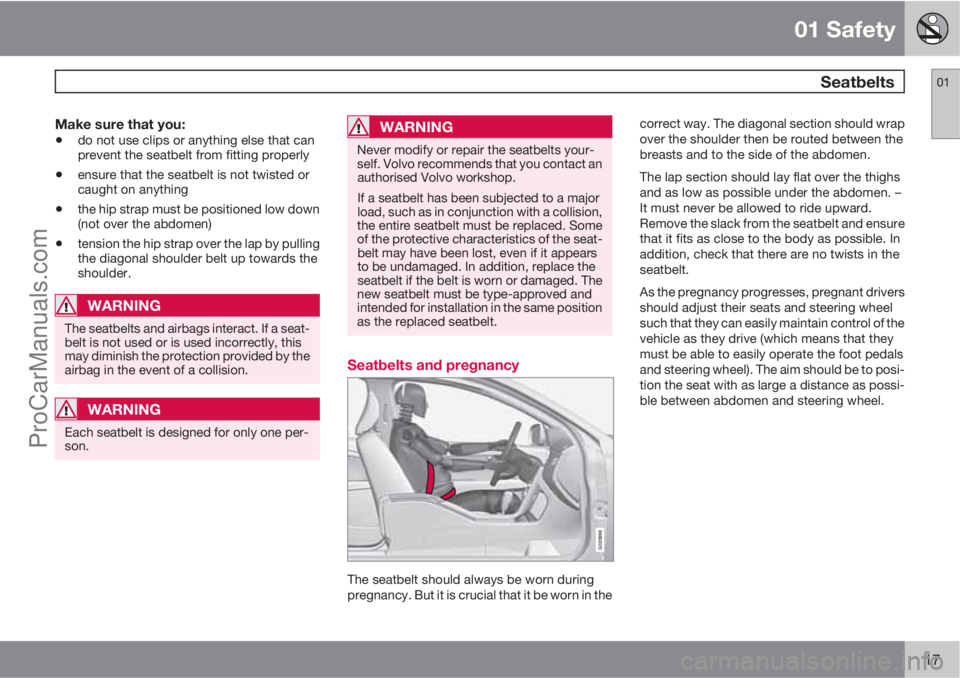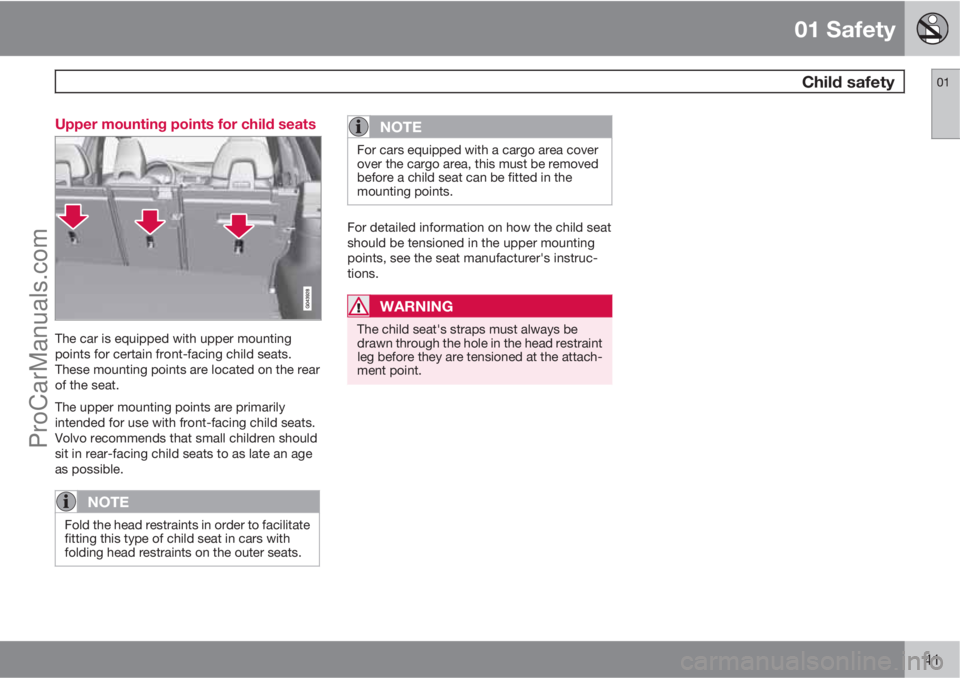2013 VOLVO V60 remove seats
[x] Cancel search: remove seatsPage 19 of 422

01 Safety
Seatbelts01
17
Make sure that you:
•do not use clips or anything else that can
prevent the seatbelt from fitting properly
•ensure that the seatbelt is not twisted or
caught on anything
•the hip strap must be positioned low down
(not over the abdomen)
•tension the hip strap over the lap by pulling
the diagonal shoulder belt up towards the
shoulder.
WARNING
The seatbelts and airbags interact. If a seat-
belt is not used or is used incorrectly, this
may diminish the protection provided by the
airbag in the event of a collision.
WARNING
Each seatbelt is designed for only one per-
son.
WARNING
Never modify or repair the seatbelts your-
self. Volvo recommends that you contact an
authorised Volvo workshop.
If a seatbelt has been subjected to a major
load, such as in conjunction with a collision,
the entire seatbelt must be replaced. Some
of the protective characteristics of the seat-
belt may have been lost, even if it appears
to be undamaged. In addition, replace the
seatbelt if the belt is worn or damaged. The
new seatbelt must be type-approved and
intended for installation in the same position
as the replaced seatbelt.
Seatbelts and pregnancy
G020998
The seatbelt should always be worn during
pregnancy. But it is crucial that it be worn in thecorrect way. The diagonal section should wrap
over the shoulder then be routed between the
breasts and to the side of the abdomen.
The lap section should lay flat over the thighs
and as low as possible under the abdomen. –
It must never be allowed to ride upward.
Remove the slack from the seatbelt and ensure
that it fits as close to the body as possible. In
addition, check that there are no twists in the
seatbelt.
As the pregnancy progresses, pregnant drivers
should adjust their seats and steering wheel
such that they can easily maintain control of the
vehicle as they drive (which means that they
must be able to easily operate the foot pedals
and steering wheel). The aim should be to posi-
tion the seat with as large a distance as possi-
ble between abdomen and steering wheel.
ProCarManuals.com
Page 43 of 422

01 Safety
Child safety01
41 Upper mounting points for child seats
The car is equipped with upper mounting
points for certain front-facing child seats.
These mounting points are located on the rear
of the seat.
The upper mounting points are primarily
intended for use with front-facing child seats.
Volvo recommends that small children should
sit in rear-facing child seats to as late an age
as possible.
NOTE
Fold the head restraints in order to facilitate
fitting this type of child seat in cars with
folding head restraints on the outer seats.
NOTE
For cars equipped with a cargo area cover
over the cargo area, this must be removed
before a child seat can be fitted in the
mounting points.
For detailed information on how the child seat
should be tensioned in the upper mounting
points, see the seat manufacturer's instruc-
tions.
WARNING
The child seat's straps must always be
drawn through the hole in the head restraint
leg before they are tensioned at the attach-
ment point.
ProCarManuals.com
Page 80 of 422

03 Your driving environment
Key positions
03
78* Option/accessory, for more information, see Introduction.
Insert and remove the remote control
key
Ignition switch with remote control key extracted/
inserted.
NOTE
For cars with the Keyless* function the key
does not need to be inserted into the ignition
switch but can be stored in e.g. a pocket.
For more information on Keyless functions -
see page 53.
Insert the key1. Hold the end of the remote control key with
the detachable key blade and insert the key
in the ignition switch.
2. Then press the key in the lock up to its end
position.
IMPORTANT
Foreign objects in the ignition switch may
jeopardise the function or destroy the lock.
Do not press the remote control key incor-
rectly turned - Hold the end with the detach-
able key blade, see page 48.
Withdraw the key
•Push the remote control key, allow it to
eject, then pull it out from the ignition
switch.
Functions at different levels
In order to enable the use of a limited number
of functions with the engine switched off, the
car's electrical system can be set in 3 different
levels (key positions) - 0, I and II - with the
remote control key. Throughout this owner's
manual these levels are described using the
denomination "key positions".
The following table shows the functions avail-
able in each key position/level.
LevelFunctions
0•Odometer, clock and tem-
perature gauge are illumi-
nated.
•Power seats can be adjusted.
•The audio system can be
used for a limited time - see
page 234.
I•Sunroof, power windows, 12
V socket in the passenger
compartment, RTI, phone,
ventilation fan and wind-
screen wipers can be used.
II•The headlamps come on.
•Warning/indicator lamps illu-
minate for 5 seconds.
•Several other systems are
activated. However, heating
in seat cushions and the rear
window can only be activated
after the engine has been
started.
This key position consumes a
lot of current from the starter
battery and should therefore be
avoided!
ProCarManuals.com
Page 416 of 422

11 Alphabetical Index
11
414
Manual gearbox....................................... 121
GSI - Gear selector assistance........... 121
towing and recovery........................... 304
Manual gear positions (Geartronic).......... 123
Max. roof load ......................................... 373
Media, Bluetooth
�Ÿ ................................... 259
media player ........................................... 252
Memory function in seats.......................... 81
Menu navigation, Infotainment ............... 238
Menus/functions...................................... 204
Menus and messages.............................. 200
Menu system MY CAR............................202
Messages and symbols
Adaptive Cruise Control..................... 162
Collision Warning with Auto
Brake..........................................171, 179
Distance Alert..................................... 167
Driver Alert Control............................. 183
Lane Departure Warning..................... 186
Messages in BLIS.................................... 196
Messages in the combined instrument
panel........................................................200
Messages in the information display....... 147Meters
fuel gauge............................................. 72
speedometer......................................... 72
tachometer........................................... 72
Microphone.............................................. 262
Misting..................................................... 217
attending to the windows...................210
condensation in headlamps............... 361
remove with the air vents................... 219
timer function...................................... 217
Mobile phone
connect............................................... 263
handsfree............................................ 262
register phone..................................... 263
voice control....................................... 271
Mood lighting............................................. 93
MY CAR................................................... 202
O
Oil, see also Engine oil............................. 378
Oil level low.............................................. 329
Overheating............................................. 298
Owner's manual, environmental labelling. . 12
P
PACOS....................................................... 22
PACOS, switch.......................................... 22
Paintwork
colour code......................................... 365
damage and touch-up........................ 365
Panel lighting............................................. 86
Panic function............................................ 46
Park assist camera.................................. 191
Parking assistance................................... 188
parking assistance sensors................ 190
Parking brake........................................... 137
Parking heater.......................................... 220
battery and fuel................................... 220
parking on a hill..................................220
time setting......................................... 222
Passenger compartment.........................227
Passenger compartment filter................. 210
Passenger compartment heater
fuel-driven........................................... 220
PCC – Personal Car Communicator
functions............................................... 45
range............................................... 46, 47
Pedestrian protection..............................173
ProCarManuals.com